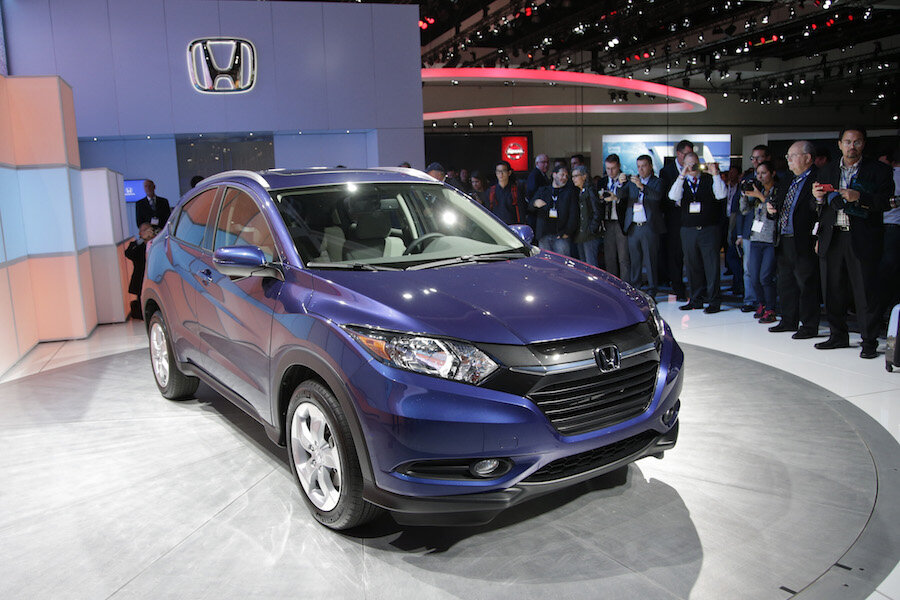Chevrolet Trax vs. Honda HR-V: How these small SUVs stack up
Loading...
We're in the midst of a small-SUV explosion, with new entry-level vehicles arriving every year from major automakers. They blend tall hatchback bodies with the all-wheel drive that qualifies them as crossover SUVs.
Both the Chevrolet Trax and the Honda HR-V are recent new entries in the niche, and two years later, Chevy has already updated its entry.
Each is a smaller sibling to a popular vehicle: the HR-V to the CR-V, the Trax to the well-known Equinox. Both are among the more spacious small SUVs, and are well suited to city and suburban use by couples or young families. Optional all-wheel drive gives secure traction for unplowed roads and the occasional muddy trail.
When it was launched, Chevy's designers played it safe with the Trax. It was relatively anonymous, almost the generic small SUV—not bad, just bland. For 2017, an updated front fascia, grille, and headlamps give it a fresh and more distinctive look. The rear fascia is new, too, and LED signature lighting and taillights are available on higher-end models. However, the base model still has budget-grade black door-mirror pedestals, and it lacks roof rails and some chrome trim.
The Honda's more exaggerated styling works to disguise the "tall hatchback on wheels" shape of most utility vehicles. It's rakish, using the brand's latest styling language to give the HR-V more pizzazz—a thick chrome top bar in the grille, swept-back front light units, and strongly etched side accent lines. At the rear, though, it's a shrunken copy of the latest Acura MDX.
Inside, the Trax gets a redesigned instrument panel and dashboard for 2017, trading a motorcycle-style cluster with digital readouts for a more flowing design with analog gauges. There's chrome trim added, and available contrast stitching. The look is more traditional, and certainly improved, but hard plastic surfaces remain, and the overall effect is still utilitarian and practical.
The HR-V's cabin has better finishes and materials than the related Honda Fit hatchback. The clean surfaces have a few foibles, like the slim air vents cut into the passenger-side dash. Overall, the interior has more flourishes and "design elements" than other small SUVs.
Both vehicles offer comfortable seats, quiet rides on decent pavement, and a roster of the latest infotainment and electronic safety systems that would have been seen only in luxury cars not so many years ago. Neither of these vehicles is likely to be used off-road much—or at all—so they're tuned for on-road finesse and comfort.
The Trax comes as a base model with front-wheel drive, and offers all-wheel drive as an option. It has only a single powertrain: a 1.4-liter turbocharged 4-cylinder engine, making 138 horsepower and paired to a six-speed automatic transmission. That gives it adequate power, though it's not particularly quick. Fuel economy ratings for the Trax are 29 mpg combined for the front-wheel-drive version, dropping to 27 mpg if you add all-wheel drive.
The HR-V has a 141-horsepower 1.8-liter four-cylinder engine, paired to either a continuously variable transmission or a six-speed manual. All-wheel drive is an option, but only with the CVT. The most fuel-efficient model of the HR-V (front-wheel drive and CVT) delivers a combined 31-mpg EPA rating, near the top of the burgeoning class of mini-SUVs.
The HR-V has adequate power, but it's not notably quick either—although it's enough for safe highway merges. It handles well enough, although the high seating positions makes body roll more obvious.
Rather to our surprise, the Chevy Trax can hold four adult-sized people in reasonable comfort. Five is a very tight squeeze, with rear-seat riders needing to stagger their shoulders, but it's possible. The straightforward and practical Trax has lots of trays, bins, cupholders, and the like to hold your gear. And the front seats can fold flat to carry long items diagonally.
One of the Honda's biggest advantages over competitors is interior volume. The rear seat of the HR-V will accommodate two adults with generous head and leg room, plus the two up front. The HR-V is by far the roomiest vehicle in the segment, and it includes a version of Honda's unique "Magic Seat," which creates a surprising abundance of cargo space if you fold both sections.
Chevrolet has achieved top safety ratings for the Trax from the Insurance Institute for Highway Safety (IIHS), which named last year's model a Top Safety Pick. It also earned five out of five stars overall from the National Highway Traffic Safety Administration (NHTSA). A rearview camera system is standard, as are electronic stability control with rollover mitigation, and a total of ten airbags. For 2017, Chevrolet also offers blind spot monitors, rear cross-traffic alerts, forward collision alert, and lane departure warning—which could earn the 2017 Trax an IIHS Top Safety Pick+ designation.
The HR-V gets five stars from the NHTSA, but the Insurance Institute for Highway Safety (IIHS) only rates it as "acceptable" in side-impact and small-overlap crash tests. It has a more limited array of electronic active-safety systems as options.
The Trax and HR-V are similarly priced, with a base six-speed manual, front-wheel-drive model around $20,000.
In the end, the Chevy Trax was slightly outscored by the Honda HR-V in performance, comfort, and fuel economy, although it wins on safety. Both offer more spacious cabins and better rear-seat room than competitors like the Jeep Renegade and the Mazda CX-3.
Each is a modern and capable small utility, but they're both all-rounders for the mass market, not competitors for similar crossovers that specialize in off-road ability or sporty handling. Both the Trax and the HR-V are likely to suit a buyer looking for a comfortable and accomplished small SUV; we suggest buyers should drive each to see which they prefer.







